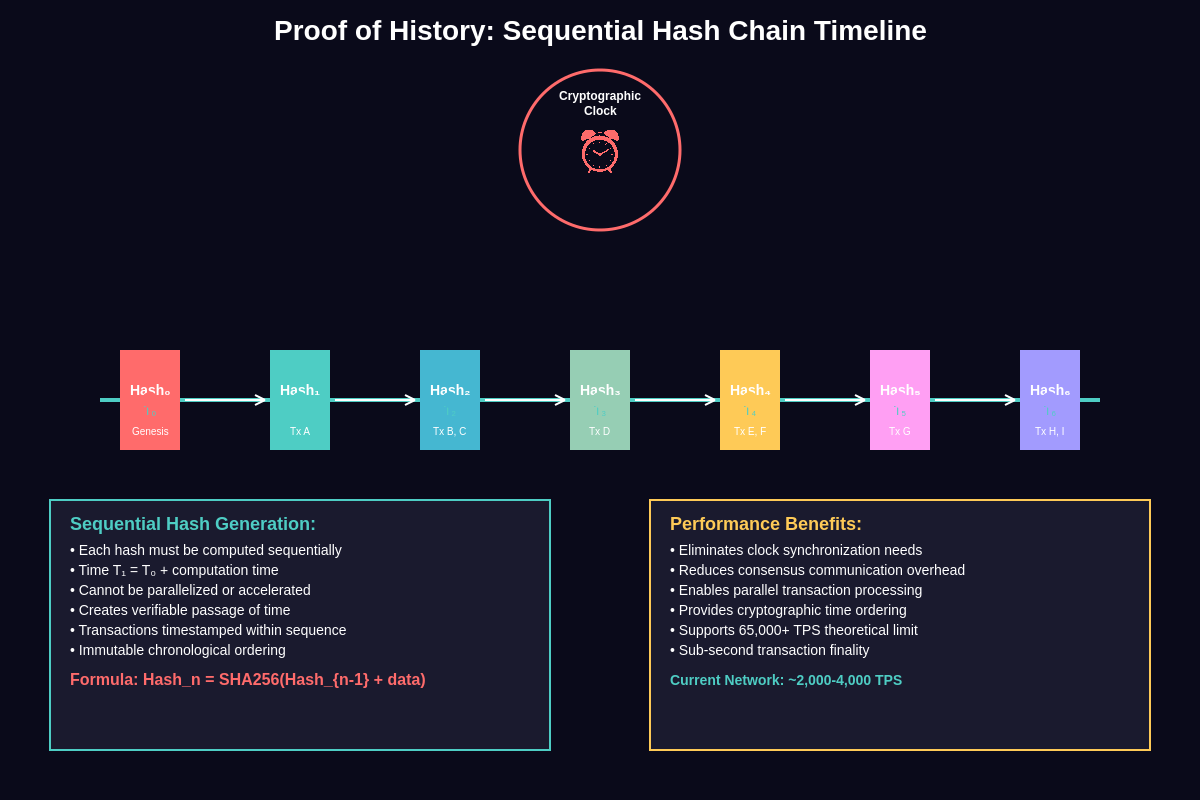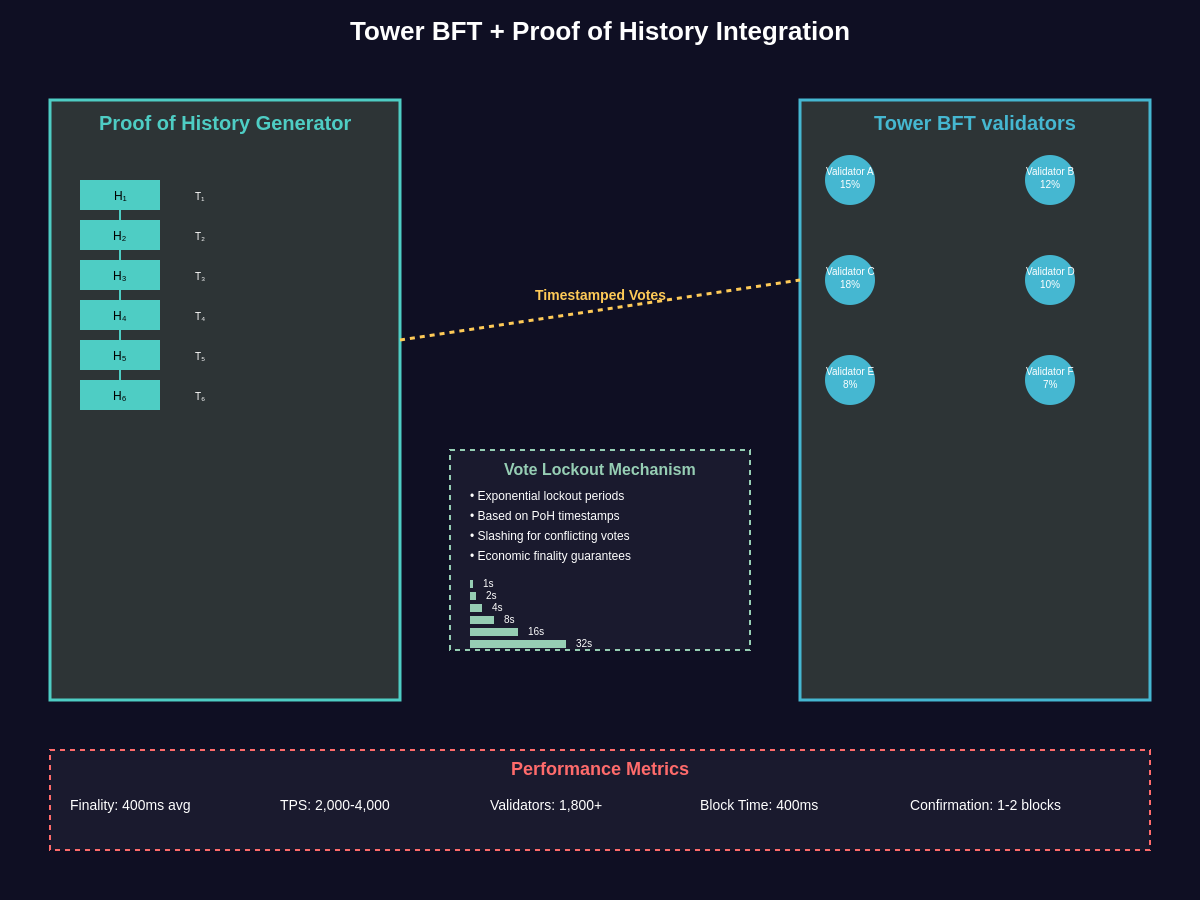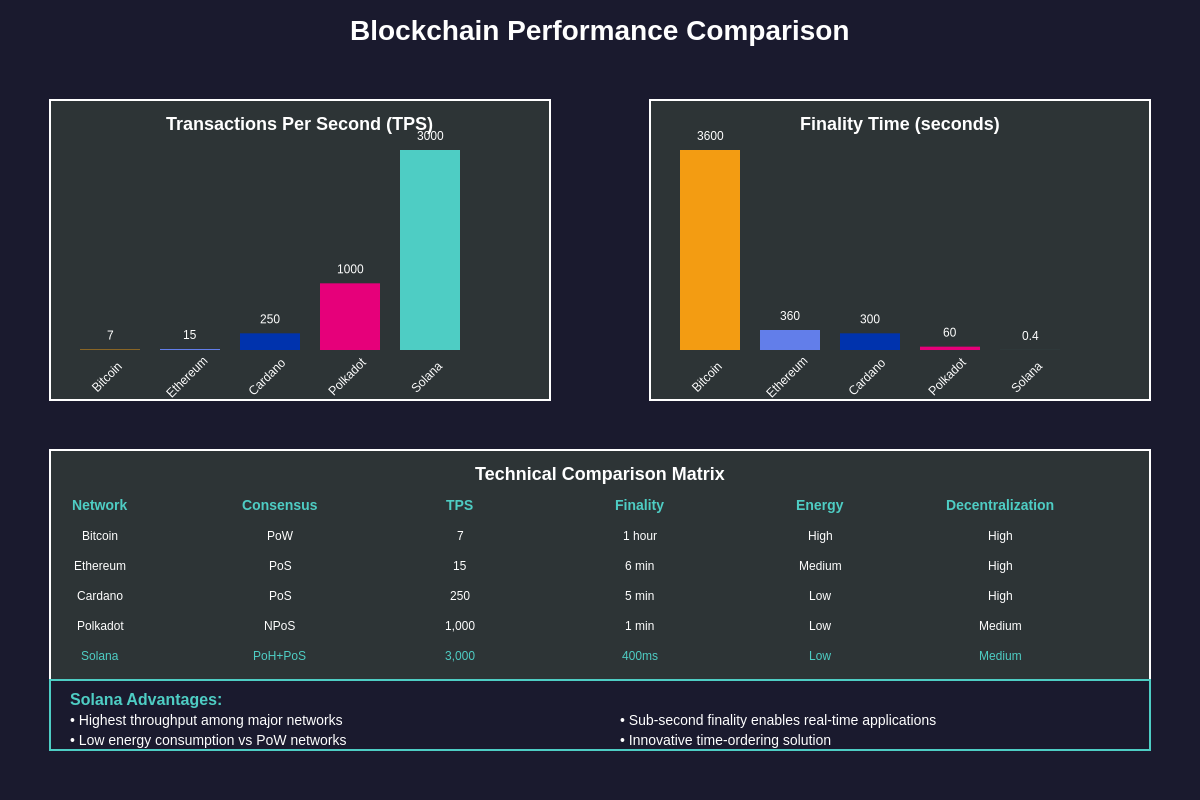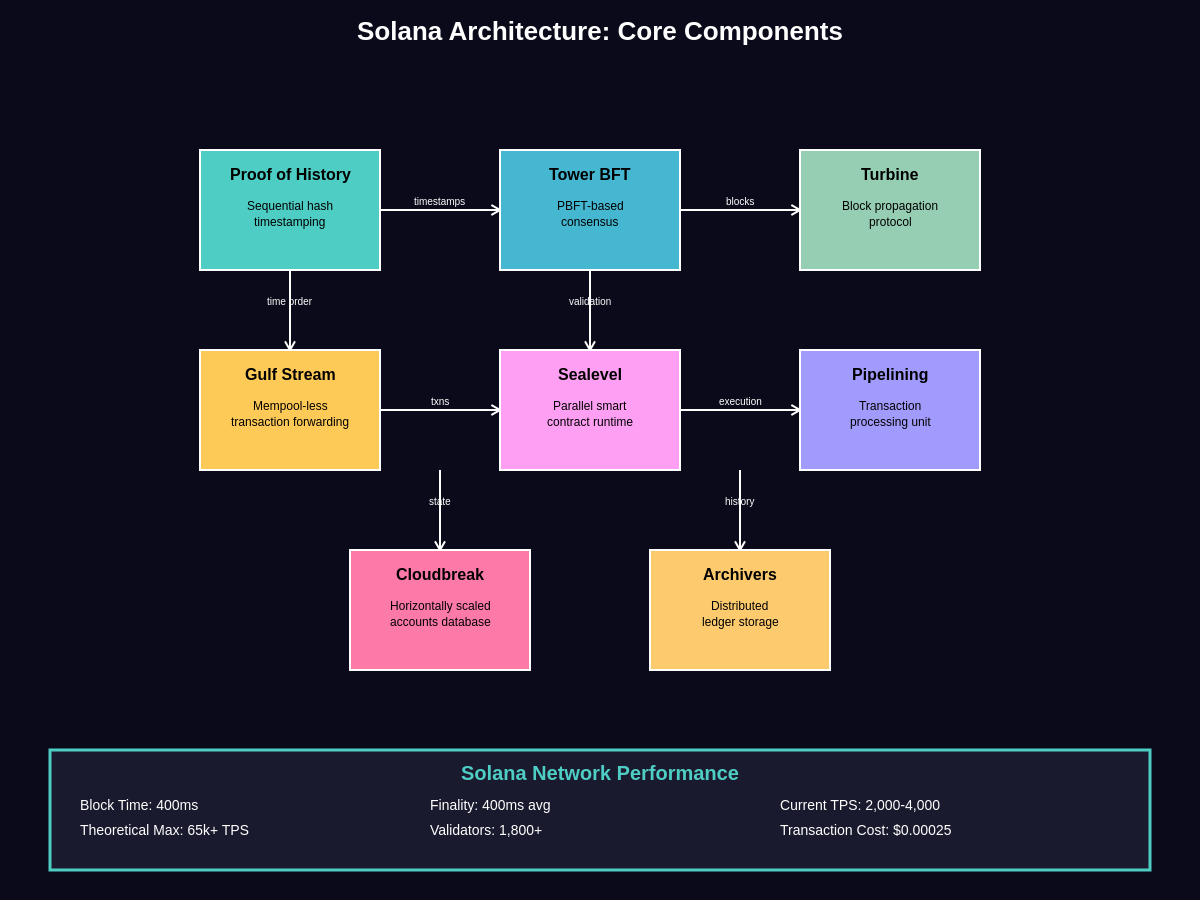Advanced trading strategies and market analysis have become essential tools for cryptocurrency investors seeking to understand the technical foundations that drive blockchain performance and market dynamics.
Revolutionary Innovation in Blockchain Consensus
Solana’s Proof of History represents one of the most significant innovations in blockchain consensus mechanisms since the introduction of Proof of Stake, fundamentally reimagining how distributed networks can achieve agreement while maintaining unprecedented transaction throughput and low latency. This groundbreaking approach addresses the core challenge that has limited blockchain scalability for over a decade by introducing a cryptographic clock that enables nodes to agree on the temporal ordering of events without the extensive communication overhead that characterizes traditional consensus protocols.
The conceptual breakthrough underlying Proof of History lies in its ability to create a verifiable passage of time within the blockchain network itself, eliminating the need for nodes to communicate extensively about when transactions occurred and allowing the network to process transactions with remarkable efficiency. By establishing a historical record that proves specific events occurred at particular moments in time, Solana creates a foundation for consensus that dramatically reduces the computational and communication requirements typically associated with distributed agreement protocols.
Technical Foundation of Proof of History
The technical implementation of Proof of History relies on a cryptographic technique that creates a sequential hash chain where each hash proves that a specific amount of real time has passed between events. This mechanism employs a verifiable delay function that requires a predetermined number of sequential steps to compute, creating a cryptographic proof that time has elapsed without relying on external timekeeping mechanisms or extensive node coordination.

The core algorithm begins with a starting hash value and repeatedly applies a SHA-256 hash function in a continuous loop, creating a chain of hashes where each subsequent hash can only be computed after the previous one is complete. This sequential nature ensures that the time between any two hashes in the chain represents the actual computational time required to generate the intermediate hashes, creating an immutable timestamp that can be verified by any network participant.
Each hash in the Proof of History sequence includes not only the previous hash but also any transactions or events that occurred during that time period, effectively weaving the transaction history into the temporal record itself. This integration means that the chronological ordering of transactions becomes an inherent property of the blockchain rather than something that must be negotiated through consensus protocols, enabling dramatic improvements in processing speed and network efficiency.
The mathematical properties of the hash function ensure that the sequence cannot be parallelized or accelerated beyond the natural speed of sequential computation, making it impossible for malicious actors to manipulate the temporal record or create false timestamps. This cryptographic guarantee provides the foundation for trust in the system while eliminating the need for complex time synchronization protocols that burden other blockchain networks.
Integration with Tower Byzantine Fault Tolerance
Solana’s consensus mechanism combines Proof of History with a modified version of Practical Byzantine Fault Tolerance called Tower BFT, creating a hybrid system that leverages the temporal ordering provided by PoH to achieve consensus with minimal communication overhead. Tower BFT uses the cryptographic timestamps from Proof of History as a source of truth for transaction ordering, allowing validators to make consensus decisions based on verifiable temporal information rather than extensive message passing between nodes.

The integration works by having validators use their Proof of History generators to timestamp their votes and consensus messages, creating a clear temporal sequence that other validators can verify and use to determine the canonical order of transactions and blocks. This approach eliminates many of the communication rounds required by traditional Byzantine Fault Tolerance protocols while maintaining the same security guarantees against malicious actors and network failures.
Tower BFT introduces the concept of vote lockouts that increase exponentially with the depth of the vote, creating economic incentives for validators to vote consistently while providing strong finality guarantees for confirmed transactions. The temporal information from Proof of History enables these lockouts to be based on verifiable time rather than block numbers, creating more predictable and reliable finality characteristics for applications built on the Solana network.
The synergy between Proof of History and Tower BFT enables Solana to achieve sub-second finality for transactions while processing thousands of transactions per second, performance characteristics that were previously thought to require significant trade-offs in decentralization or security. This breakthrough demonstrates how innovative consensus mechanisms can overcome traditional blockchain trilemma limitations through creative cryptographic engineering and protocol design.
Performance Advantages and Scalability
The performance improvements enabled by Proof of History extend beyond simple transaction throughput to include dramatic reductions in network latency, bandwidth requirements, and computational overhead for consensus operations. By eliminating the need for extensive time synchronization and reducing communication requirements for consensus, Solana can dedicate more network resources to transaction processing and state updates rather than coordination overhead.
Current performance metrics demonstrate Solana’s ability to process over 65,000 transactions per second in optimal conditions, with typical network performance ranging from 2,000 to 4,000 transactions per second depending on network conditions and transaction complexity. These throughput numbers represent improvements of several orders of magnitude compared to traditional Proof of Work networks and significant improvements over other Proof of Stake implementations that lack the temporal optimization provided by Proof of History.
The scalability advantages of Proof of History become particularly apparent when analyzing network behavior under high load conditions, where traditional consensus mechanisms often experience dramatic performance degradation as communication overhead increases exponentially with transaction volume. Solana’s approach maintains relatively stable performance characteristics even as transaction volume increases, making it suitable for applications that require predictable performance at scale.
Network latency benefits are equally impressive, with typical transaction confirmation times measured in milliseconds rather than seconds or minutes required by other blockchain networks. This low latency enables new categories of applications including high-frequency trading, real-time gaming, and interactive financial applications that were previously impractical on blockchain networks due to performance limitations.
Cryptographic Security and Attack Resistance
The security model of Proof of History relies on the computational difficulty of generating false timestamps and the cryptographic properties of hash functions to prevent manipulation of the temporal record. The sequential nature of the hash chain means that any attempt to create alternative histories would require regenerating the entire sequence of hashes from the point of deviation, a computationally intensive process that becomes exponentially more difficult as the legitimate chain continues to grow.
Attack vectors against Proof of History primarily focus on attempts to manipulate the timing sequence or create parallel histories that could confuse network participants about the canonical ordering of transactions. However, the cryptographic properties of the system make such attacks extremely difficult and economically irrational, as the computational resources required to successfully execute such attacks would far exceed any potential gains from the manipulation.
The integration with Tower BFT provides additional security layers by requiring economic stake from validators and implementing slashing conditions that penalize malicious behavior. Validators who attempt to create conflicting votes or timestamps face significant financial penalties, creating strong economic incentives for honest behavior while maintaining the decentralized nature of the network.
Network resilience against various attack scenarios has been extensively tested through both theoretical analysis and practical stress testing, demonstrating robust performance even under adversarial conditions including network partitions, validator failures, and coordinated attacks by malicious actors. The combination of cryptographic security and economic incentives creates a defense-in-depth approach that protects against both technical and economic attack vectors.
Validator Requirements and Network Participation
Participation as a validator in the Solana network requires significant computational resources and technical expertise due to the demanding requirements of running Proof of History generators and maintaining network synchronization at high transaction throughput levels. Validators must operate high-performance hardware capable of generating the continuous hash sequences required for Proof of History while simultaneously processing transactions and participating in consensus protocols.
The hardware requirements for Solana validators are considerably higher than those for many other blockchain networks, with recommendations including powerful multi-core processors, substantial memory allocation, and high-speed internet connections to handle the volume of network traffic generated by high-throughput operations. These requirements create barriers to entry that may limit decentralization compared to networks with lower hardware requirements, though they are necessary to achieve the performance characteristics that define Solana’s value proposition.
Economic requirements for validator participation include both the direct costs of operating high-performance hardware and the opportunity costs of staking significant amounts of SOL tokens to participate in consensus. The staking mechanism requires validators to lock up substantial capital, creating economic incentives for honest behavior while generating returns through transaction fees and block rewards for successful participation in network consensus.
The geographic distribution of validators and the concentration of stake among large operators has raised questions about the long-term decentralization characteristics of the Solana network, particularly as hardware requirements continue to increase with network growth and performance tracking through specialized analytics platforms becomes essential for validator operations. Ongoing development efforts focus on optimizing performance requirements while maintaining security and throughput characteristics.
Comparison with Alternative Consensus Mechanisms
When compared to traditional Proof of Work consensus mechanisms like those used by Bitcoin, Proof of History offers dramatic improvements in energy efficiency, transaction throughput, and network latency while maintaining strong security guarantees through different cryptographic and economic mechanisms. The elimination of energy-intensive mining operations reduces environmental impact while enabling much higher transaction processing capacity and faster confirmation times.

Relative to other Proof of Stake implementations, Solana’s approach provides significant advantages in transaction throughput and latency through the temporal optimization enabled by Proof of History, though these benefits come with trade-offs in hardware requirements and validator accessibility. Networks like Ethereum 2.0 and Cosmos prioritize different aspects of the blockchain trilemma, offering greater validator accessibility at the cost of lower raw performance metrics.
The comparison with alternative high-performance blockchain networks reveals various approaches to scalability challenges, with different projects making different trade-offs between decentralization, security, and performance. Solana’s approach represents one extreme of the performance spectrum, prioritizing throughput and latency optimization while maintaining acceptable levels of decentralization and security for most use cases.
Understanding these trade-offs is crucial for evaluating the suitability of different blockchain networks for specific applications and use cases, as the optimal choice depends heavily on the particular requirements and constraints of the intended application. Market analysis tools help investors and developers evaluate these technical characteristics in the context of broader market dynamics and adoption trends.
Real-World Implementation Challenges
The practical implementation of Proof of History in production environments has revealed various technical challenges that continue to evolve as the network scales and matures. Clock drift between validators can create synchronization issues that require careful management to maintain network coherence, particularly as the network grows and includes validators with varying hardware configurations and network conditions.
Network congestion during high-demand periods has occasionally resulted in degraded performance or transaction failures, highlighting the ongoing challenges of maintaining consistent performance under variable load conditions. These issues have led to continuous improvements in network optimization and protocol refinements to better handle peak usage scenarios while maintaining the fundamental performance advantages of the Proof of History approach.
Software complexity associated with implementing and maintaining Proof of History generators creates additional operational overhead for validators and development teams, requiring specialized expertise and robust operational procedures to ensure network stability and security. The continuous evolution of the protocol and regular network upgrades demand significant technical resources from network participants and ecosystem developers.
Integration challenges with existing blockchain infrastructure and tooling have required extensive development of Solana-specific solutions for wallet software, development frameworks, and analytical tools. While this ecosystem has matured significantly, the unique characteristics of Solana’s architecture continue to require specialized approaches that may not be compatible with tools designed for other blockchain networks.
Economic Implications and Token Economics
The economic model underlying Solana’s consensus mechanism creates unique incentive structures that differ significantly from other blockchain networks, with implications for token distribution, validator rewards, and long-term network sustainability. Transaction fees on Solana are deliberately kept low to encourage high-frequency usage, creating a different economic dynamic compared to networks where fees serve as the primary mechanism for managing network congestion.
Validator economics depend heavily on both transaction fee collection and inflationary token rewards, with the balance between these revenue sources affecting the long-term sustainability of network security and decentralization. The high hardware requirements for validator participation create significant operational costs that must be balanced against revenue opportunities to maintain a healthy validator ecosystem.
Token supply dynamics include planned inflation to fund validator rewards while implementing burning mechanisms to control long-term supply growth, creating complex economic relationships that affect both network security and token value dynamics. Understanding these mechanisms is crucial for evaluating the long-term economic sustainability of the network and making informed investment decisions.
The relationship between network usage, transaction fees, and validator economics creates feedback loops that influence network growth and development, with high usage potentially creating virtuous cycles of increased fee revenue and network security. Professional trading platforms provide essential tools for analyzing these economic relationships and their impact on token price dynamics and network fundamentals.
Future Developments and Protocol Evolution
Ongoing research and development efforts focus on further optimizing the Proof of History mechanism to handle even higher transaction volumes while reducing hardware requirements and improving validator accessibility. Protocol improvements under development include optimizations to the hash function implementation, more efficient consensus message formats, and improved network synchronization mechanisms that could enhance performance while reducing operational complexity.
The integration of additional scaling solutions including state compression, account abstraction, and various Layer 2 approaches represents significant opportunities to extend Solana’s performance advantages while addressing some of the current limitations related to state growth and computational requirements. These developments could enable new categories of applications while maintaining the fundamental performance characteristics that distinguish Solana from other blockchain networks.
Research into quantum-resistant cryptographic approaches acknowledges the long-term need to ensure the security of Proof of History mechanisms against potential future threats from quantum computing advances. While current quantum computers pose no immediate threat to the cryptographic foundations of Proof of History, proactive research ensures the long-term viability of the consensus mechanism.
The evolution of the broader blockchain ecosystem and the emergence of new consensus mechanisms continue to influence Solana’s development priorities, with ongoing efforts to maintain competitive advantages while addressing legitimate concerns about decentralization, accessibility, and long-term sustainability. The balance between innovation and stability remains a key consideration as the network continues to mature and expand its role in the broader cryptocurrency ecosystem.
Impact on Decentralized Applications
The unique performance characteristics enabled by Proof of History have catalyzed the development of new categories of decentralized applications that were previously impractical on blockchain networks due to latency and throughput limitations. High-frequency trading applications, real-time gaming platforms, and interactive financial instruments represent just a few examples of applications that leverage Solana’s performance advantages to deliver user experiences comparable to traditional centralized systems.

The low transaction costs and fast confirmation times enable microtransaction business models that are economically viable on Solana but prohibitively expensive on other blockchain networks, opening new possibilities for content monetization, digital collectibles, and pay-per-use service models. These economic advantages have contributed to rapid growth in the Solana ecosystem and the development of innovative applications across various sectors.
Developer experience benefits from Solana’s consistent performance characteristics include more predictable application behavior, reduced complexity in handling transaction failures and delays, and the ability to build applications with real-time user interaction requirements. However, the unique architecture also requires developers to learn Solana-specific development patterns and tools that may not transfer directly to other blockchain platforms.
The growing ecosystem of Solana-based applications demonstrates the practical impact of consensus mechanism innovations on real-world utility and adoption, with performance advantages translating into tangible benefits for both developers and end users. Market tracking capabilities help investors evaluate the relationship between technical capabilities and ecosystem growth across different blockchain networks.
Disclaimer: This article is for educational and informational purposes only and should not be construed as financial advice. Cryptocurrency investments carry significant risks, including the potential for total loss of capital. The technical analysis and market commentary provided are based on current information and market conditions, which can change rapidly. Always conduct your own research and consult with qualified financial advisors before making investment decisions. Past performance does not guarantee future results, and the volatile nature of cryptocurrency markets means that prices can fluctuate dramatically. The author and publication are not responsible for any financial losses that may result from trading or investment decisions based on the information provided in this article.